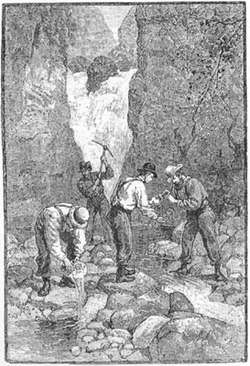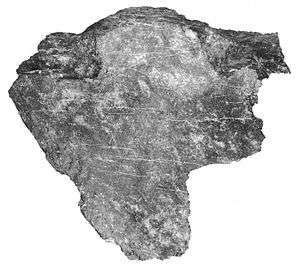Georgia Gold Rush
The Georgia Gold Rush was the second significant gold rush in the United States and the first in Georgia, and overshadowed the previous rush in North Carolina. It started in 1829 in present-day Lumpkin County near the county seat, Dahlonega, and soon spread through the North Georgia mountains, following the Georgia Gold Belt. By the early 1840s, gold became difficult to find. Many Georgia miners moved west when gold was found in the Sierra Nevada in 1848, starting the California Gold Rush. Since the 16th century, American Indians in Georgia told European explorers that the small amounts of gold which they possessed came from mountains of the interior. Some poorly documented accounts exist of Spanish or French mining gold in North Georgia between 1560 and 1690, but they are based on supposition and on rumors passed on by Indians.[1] In summing up known sources, Yeates observed: "Many of these accounts and traditions seem to be quite plausible. Nevertheless, it is hardly probable that the Spaniards would have abandoned mines which were afterwards found to be quite profitable, as those in North Georgia."[2]
 | |
| Date | 1828 - early 1840s |
|---|---|
| Location | Georgia, United States |
| Also known as | Great Intrusion |
| Participants | prospectors |
| Outcome | Gold became difficult to find by the early 1840s causing the Georgia Gold Rush to come to an end and experienced miners would later go west to seek their fortune in the 1848 California Gold Rush |
Gold rush

No matter who made the gold discovery in 1828, the gold rush started in 1829 in Lumpkin County and began spreading rapidly. One of the first public accounts was on August 1, 1829, when the Georgia Journal (a Milledgeville newspaper), ran the following notice.
GOLD.—A gentleman of the first respectability in Habersham county, writes us thus under date of 22d July: "Two gold mines have just been discovered in this county, and preparations are making to bring these hidden treasures of the earth to use." So it appears that what we long anticipated has come to pass at last, namely, that the gold region of North and South Carolina, would be found to extend into Georgia.[4]
The Macon Telegraph reported that in "the winter of 1829 and 30, when the precious metals having been discovered in great abundance upon our Cherokee soil, great numbers of people from Georgia and other States rushed to the Territory in search of its treasures."[3]:25
Gold was discovered in Carroll County, Georgia, in 1830.[3]:28 Although much of the land on which the gold was found was under the control of the Cherokee, mining operations quickly sprang up in Lumpkin, White, Union, and Cherokee counties in the "Great Intrusion". In the early stages of the gold rush, the majority of the mining was placer mining. By 1830, Nile's Register estimated that there were 4,000 miners working on Yahoola Creek alone,[3]:25 and over 300 ounces (8.5 kg) of gold per day were being produced in an area from north of Blairsville to the southeast corner of Cherokee County. The Philadelphia Mint received $212,000 in gold from Georgia in 1830.[3]:28
Other estimates were that in 1831 there were 6,000 to 10,000 miners between the Chestatee River and the Etowah River. Boom towns like Auraria and Dahlonega began to appear. and Dahlonega was said to have supported 15,000 miners at the height of the gold rush. During this rapid influx of prospectors and settlers, tensions with the Cherokee increased. Before long, gold mines appeared in most counties in the North Georgia mountains, including Georgia's northeastern-most county, Rabun.
The culmination of tensions between the Cherokee and various states, including Georgia, led to the forced migration of Native Americans, later known as the Trail of Tears.[5] President Andrew Jackson authorized the Indian Removal Act in 1830, which would allow a takeover of the gold mining areas among other places. The Cherokee Nation turned to the federal court system to avoid being forced off their ancestral lands. The Supreme Court first ruled in favor of the State of Georgia in the 1831 case Cherokee Nation v. Georgia, but the following year, in Worcester v. Georgia reversed this decision to recognize the Cherokee as a sovereign nation.[6] Jackson proceeded with removal of remaining Cherokee from the North Georgia gold fields.[7]
The Philadelphia Mint received over half a million dollars in gold from Georgia in 1832.[3]:28 The state of Georgia held the Gold Lottery of 1832 and awarded land, which had been owned by the Cherokee, to the winners in 40-acre (16 ha) tracts. The Philadelphia Mint received $1,098,900 in gold from Georgia between 1830 and 1837.[3]:80
In 1838, the Dahlonega Mint was established by Congress, as a branch of the United States Mint. This was a testimony to the amount of gold being produced in Georgia. The establishment of the Dahlonega Mint seemed to validate the state's actions in the early part of the century to seize Cherokee lands.
Besides panning and other gold-washing machines, efforts shifted to working the lode deposits, or gold-bearing quartz vein mining. This involved digging shafts and tunnels, from three to seven square feet in size, braced by timbers due to the fissures in the rock and the danger of collapse. Most mines stayed above the water table, being no more than thirty feet deep, such as the Allatoona Mine in Bartow County. The deepest was the Loud Mine, in White County, at one hundred and thirty feet.[3]:70–71
Large stamp mills appeared in 1833, at the Columbia Mine in McDuffie County. These reduced the ore to fine sand for additional panning, or for separation via mercury amalgamation.[3]:72–73 Besides the Calhoun Mine, other major gold mines included the Sixes, Logan, Elrod, Battle Branch, Pigeon Roost, Turkey Hill, Free Jim, Holt, Loud, Cleveland, Gordon, Horshaw, Lumsden, and Richardson.[3]:76
Nevertheless, by the 1840s gold mining saw a sharp decline, as the gold began to "play out".[3]:79
Aftermath
When news of the California Gold Rush reached Georgia, many miners moved west in search of more gold; the assayer of the Dahlonega Mint, M. F. Stephenson, tried to convince them to stay. He declared from the Dahlonega courthouse steps to a crowd of miners, "Why go to California? In that ridge lies more gold than man ever dreamt of. There's millions in it."[3]:118
Yet, despite the departure of many miners, the mines in the Georgia Gold Belt continued to produce gold for years. Hydraulic mining and blast mining renewed interest in the 1850s.[3]:120 There were some 500 mines in 37 different counties. The Civil War brought most operations to a halt, but a few operations continued after the war, and several mines were reworked in the 1930s, during the Great Depression.[3]:120–121
It is estimated that Georgia produced about 870,000 troy ounces (24,000 kg) of gold between 1828 and the mid-20th century, when commercial gold production ceased.[8]
Before they were expelled, the Cherokee gained enough gold-mining experience to participate in later gold rushes in California in 1849 and Colorado in 1859. Cherokee gold miners gave the name to the town of Cherokee, California,[9] as well as to a number of other geographic features in that state's gold-mining region.
Experienced gold miners from Georgia played key roles in the beginning of gold mining in Colorado. Georgia miners Lewis and Samuel Ralston, along with some displaced Georgia Cherokee, noticed placer gold near the present site of Denver, on their way to the Sierra Nevada gold fields in 1850. They returned east in 1857, having failed to strike it rich; they remembered the gold just east of the Rocky Mountains. William Greeneberry Russell led a party of Cherokee and Georgia gold miners back to Colorado in 1858, and they began placer mining along the South Platte River in present-day Denver. Three Auraria Georgians, W. Green, Levi J., and J. Oliver Russell, founded Auraria, Colorado, named after the gold-mining town in Georgia. Auraria merged with Denver in 1860, but the neighborhood is still known as Auraria.[3]:120 The town of Golden, Colorado, is named after Georgia miner Thomas L. Golden. Another Georgia gold miner, John H. Gregory, discovered the first lode gold in Colorado in 1859.[10]
In 1864, four prospectors known as "the Georgians" found one of the early gold placers in Montana, at Last Chance Gulch. The site became the state capital of Helena.[11]
References
- Duane K. Hale (1981) Mineral exploration in the Spanish borderlands 1513-1846, Jour. of the West, v.20 n.2, p.5-20.
- W.S. Yeates and others (1896) "A Preliminary Report on a Part of the Gold Deposits of Georgia", Geological Survey of Georgia, Bulletin No. 4-A, p.28.
- Williams, David, 1993, The Georgia Gold Rush: Twenty-Niners, Cherokees, and Gold Fever, Columbia: University of South Carolina Press, ISBN 1570030529
- The New Georgia Encyclopedia
- Swanson, Drew (2016). "From Georgia to California and Back: The Rise, Fall, and Rebirth of Southern Gold Mining". Georgia Historical Quarterly. 100 (2): 160.
- Pratt, Adam J. (2016). "Violence and the competition for sovereignty in Cherokee Country, 1829-1835". American Nineteenth Century History. 17 (2): 181–197. doi:10.1080/14664658.2016.1215018.
- "A Brief History of the Trail of Tears". Cherokee Nation. Retrieved 28 March 2015.
- A.H. Koschmann and M.H. Bergendahl (1968) "Principal Gold-Producing Districts of the United States", US Geological Survey, Professional Paper 610, p.119.
- William B. Clark, 1970, "Gold Districts of California," California Division of Mines and Geology, Bulletin 193, p.36.
- Robert L. Brown (1984) The Great Pikes Peak Gold Rush, Caldwell, Idaho: Caxton, p.12-32.
- Don Spritzer (1999) Roadside History of Montana, Missoula, Montana: Mountain Press, ISBN 0-87842-395-8, p.248.
Further reading
- North Georgia’s Gold Rush, About North Georgia
- Gold Rush, The New Georgia Encyclopedia
- Dahlonega Gold Museum, Roadside Georgia
- Mineral Resources of the Blue Ridge & Piedmont
- History of Georgia's Gold, Georgia Gold Prospectors Association
- The Georgia Gold Rush, Gold Rush Gallery
- Georgia Gold Mines, Etc., Goldmaps.com
- "Gold-Mining in Georgia." Harper's New Monthly Magazine 59, Issue 352 (September 1879): 517-519. Available here
External links
- An Act to authorize Governor George R. Gilmer to take possession of gold, silver and other mines in Cherokee Country, 2 December 1830. From the collection of the Georgia Archives.
- "Thar's gold in them thar hills": Gold and Gold Mining in Georgia, 1830s-1940s from the Digital Library of Georgia
- Cherokee County Gold historical marker